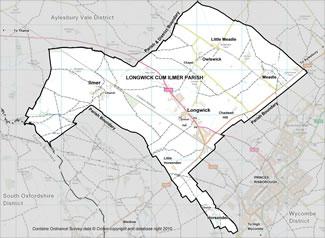-
07521 161645

The Role of the Parish Council
Parish councils are run by councillors, who volunteer their time to make their community a better place. Their work falls into three main categories:
- Representing the local community
- Delivering services to meet local needs
- Striving to improve the quality of life in the parish
History of the Parish
The Parish of Longwick-cum-Ilmer is composed of the villages of Longwick, Ilmer, Owlswick, Little Meadle and part of Horsenden. It is situated in a low lying area of open farmland adjacent to the Lower Icknield Way (B4009) The Lower Icknield Way is an ancient possibly pre-Roman route between East Anglia and Salisbury Plain. The children of the parish still continue the local tradition of making garlands of flowers in the shape of a crown or sceptre to celebrate May Day, this tradition is now incorporated in the Village Fete.
Longwick village evolved in a linear shape as it developed on either side of the old Turnpike Road, between Princes Risborough and Thame, now the A4129 and it boasts most of the facilities in the Parish. The Village Hall is run by the Management Trustees with representatives from all the user groups in the Village (see Directories). We are very proud of our thriving Church of England Combined School, which plays a central role in the village. The Red Lion is the only surviving Public House in the entire parish and it is well loved for its friendly atmosphere and reasonably priced meals. The Post Office/Village Store is well used and is a vital part of the community. This village is also home to a thriving garden machinery store, a petrol station/shop and a number of small industries centred on Walker’s Yard.
Ilmer is approached from the A4129 along a quiet “no through” road which runs under the bridge that carries the Princes Risborough to Haddenham railway line. Most of the village is within a conservation area centred on the X11 century church of St. Peter. The church holds services on the first and third Sundays in the month. The village is the centre of a network of footpaths and bridlepaths connecting to Longwick, Owlswick, Horsenden, Towersey and Bledlow.
Owlswick was once a much larger village than we see today, however in 1866 the population was large enough to warrant building a small village school which served the population as a church on Sundays (the original church was demolished during the time of the Civil war between King Charles 11 and the Parliamentary forces). The school no longer exists, but the chapel of St. Peter still holds a service on the second and fourth Sunday in the month. Most of Owlswick is part of a conservation area.
Meadle is situated on either side of a quiet “no through” road with an attractive stream meandering through many of the gardens. There are 14 Listed buildings within the Conservation Area, and some of the houses have timber frames with brick or rendered infill patterns. The open spaces, mature trees and orchards between buildings are a key part of the areas charm. The village grew up around a grouping of farms and in the past there was a strong connection with the Quaker movement.
Horsenden can be reached from Longwick along the “Phoenix” off road cycle and bridle route to Thame, but can only be approached by road via Princes Risborough and Saunderton. It has a Manor House within extensive grounds, which include ponds, lakes and a stream. The church of St. Michael is of medieval origin but in 1765 the original structure had become unsafe and much of the building was demolished, the Chancel of the old church became the Nave and a new Tower was built using stone from the old building. Services are held on the 1st and 3rd Sunday in the month at 9am.